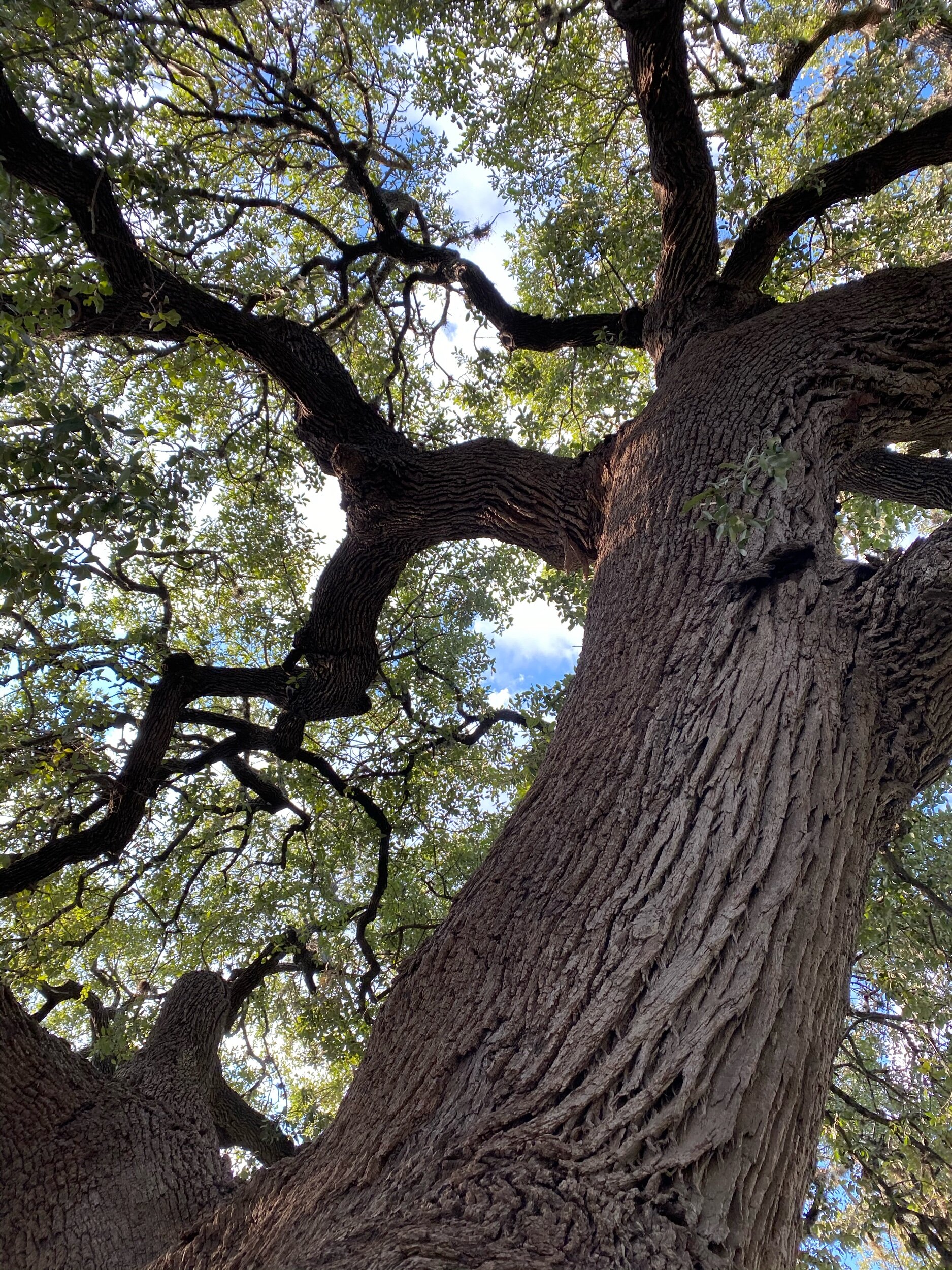
Steel’s Tavern Oaks
These oaks were allowed to stay as long as they promised not to go outside the circular cement barrier allotted for them.
Why is our culture so comfortable mowing things down?
With all due respect, these were the most underwhelming group of trees I’ve seen so far: three moderately sized live oaks included for NOT getting bulldozed in the march toward progress. Situated northwest of the Tarrant county courthouse, city construction came up around them and yet their lives were spared.
Though many have been axed, it’s easy to understand why a tree might be saved. Living much longer than we do, they quietly tower over us, commanding respect while providing shade and food for wildlife.
Land “developers” seem to think nothing of destroying a prairie, which was primarily what covered much of north Texas before it was settled. Appearing from a distance like a vast expanse of grass, prairies are an intricately woven network of perennial forbs, deep rooted grasses and self-sowing wildflowers. One pass of a mower disturbs the whole system, opening it to weed invasion.
Fun fact: Restoration takes decades and there is only a tiny percentage of native prairie remaining in the state. Rant over.
Bird by Bird
My dear niece asked to come along on one of my tree hunting excursions. I was happy to include this thoughtful sweetheart with a head full of knowledge from years of reading and an interest in birds, among many other things. She’s a delight to spend time with and has joined me on local adventures before, so we set off to find this group in Fort Worth on a pretty February weekend.
Works by Scott and Stuart Gentling at Amon Carter Museum
The Most Obvious Thing
There was another lure in Fort Worth I wanted to see that day: a painting exhibit at the Amon Carter Museum by twin brothers named Gentling. I became aware of them years ago when my ex-husband discovered these local heroes and acquired a large framed print from their masterwork Of Birds and Texas.
Growing up in Fort Worth, Scott and Stuart, inspired by the painting style of ornithologist John James Audubon, began collaborating on their own works of nature from the Lone Star State.
Turkey Vulture by Scott and Stuart Gentling
As I recall, their book’s introduction described why they chose the Buzzard, (the name Texans often use referring to Turkey Vultures), for the first image in their book: It’s the most obvious bird a casual observer would notice by simply looking up. I failed to grasp the dark symbolism of this vulture hanging above our bed until it was too late.
Plexus no. 34 by Mexican-born, Dallas-based artist Gabriel Dawe, 2016 at Amon Carter Museum. Check out this making-of video and cool time lapse.
The small show featured around 15 watercolor and gouache paintings. Take a look at these superior reproductions. The museum recently announced the Gentling Study Center for acquisition of their work along with an upcoming career retrospective. We enjoyed several other treasures on exhibit before we left to locate the Steel’s Tavern Oaks.
Back and side view of the Tarrant County Courthouse along with a fabulous yucca bloom just getting started.
Size Matters
We drove around the courthouse scoping out the oaks and searching for a parking spot, but because they are not super sized, they were hard to distinguish from the surrounding flora.
Once we found them, I’ll admit I felt disappointment. These oaks are lovely, but I felt vaguely anxious at not providing a spectacular sight for my dear companion, who was excited to see something special.
The historical marker describes the original Fort Worth Hotel…
the first built on the corner of the original fort grounds by a man known as the town’s founding father, Ephraim M. Daggett, the brother of Henry Clay Daggett, whom I learned a little about at the Trader’s Oak.
Seems like these Daggett guys knew how to party, or at least cash in on alcohol sales. Ephraim set up a tavern below his two story residence and it’s rumored that his bro occasionally served up whiskey at his place of business as well.
Another early pioneer, Lawrence Steel, bought the property a couple years later. The name: Steel’s Tavern, as it was then known, evidently stuck, later advertised as the “Best Hotel in Northern Texas.”
This website about Fort Worth, which made me feel like the history dilettante that I am, has a lot more detail about the Daggett brothers and explains not only how they were associated with Charles Turner of the Turner Oak, but also how Sam Houston stayed overnight with E. M. Daggett while campaigning for governor and discusses two more historic trees I’ll have to hunt down.
The building changed names and owners a number of times before getting demolished in 1892, leaving the trees to fend for themselves. It wasn’t until 1978 that a resolution to preserve the site and the trees was sought by Tarrant county. The trees were allowed to stay as long as they promised not to go outside the circular cement barrier allotted for them.
Nearby is a large granite slab carved with messages in various languages on which Arden quickly identified several types of early alphabets. I could understand only the one quote (below) in english. After exploring the area, we decided to hit the Trader’s Oak so she could lay eyes on a more impressive specimen.
“What was has always been. What is has always been. What will be has always been.”














